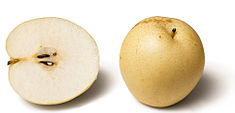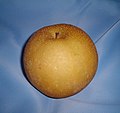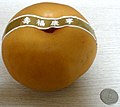| Pyrus pyrifolia | |
|---|---|

| |
| Scientific classification | |
| Kingdom: | Plantae |
| Clade: | Tracheophytes |
| Clade: | Angiosperms |
| Clade: | Eudicots |
| Clade: | Rosids |
| Order: | Rosales |
| Family: | Rosaceae |
| Genus: | Pyrus |
| Section: | Pyrus sect. Pashia |
| Species: | P. pyrifolia |
| Binomial name | |
| Pyrus pyrifolia (Burm.f.) Nak. | |
| Synonyms | |
List
| |
Pyrus pyrifolia is a species of pear tree native to southern China and northern Indochina that has been introduced to Korea, Japan and other parts of the world. The tree's edible fruit is known by many names, including Asian pear, Persian pear, Japanese pear, Chinese pear, Korean pear, Taiwanese pear, apple pear, zodiac pear, three-halves pear, papple, naspati and sand pear. Along with cultivars of P. × bretschneideri and Pyrus ussuriensis, the fruit is also called the nashi pear. Cultivars derived from Pyrus pyrifolia are grown throughout East Asia, and in other countries such Pakistan, Nepal, Australia, New Zealand, and America. Traditionally in East Asia the tree's flowers are a popular symbol of early spring, and it is a common sight in gardens and the countryside.
 Nashi pear (Pyrus pyrifolia) Nashi pear (Pyrus pyrifolia) | |||||||||||||||||||||||||||||||||||||||||||||||||
| Nutritional value per 100 g (3.5 oz) | |||||||||||||||||||||||||||||||||||||||||||||||||
|---|---|---|---|---|---|---|---|---|---|---|---|---|---|---|---|---|---|---|---|---|---|---|---|---|---|---|---|---|---|---|---|---|---|---|---|---|---|---|---|---|---|---|---|---|---|---|---|---|---|
| Energy | 176 kJ (42 kcal) | ||||||||||||||||||||||||||||||||||||||||||||||||
| Carbohydrates | 10.65 g | ||||||||||||||||||||||||||||||||||||||||||||||||
| Sugars | 7.05 g | ||||||||||||||||||||||||||||||||||||||||||||||||
| Dietary fiber | 3.6 g | ||||||||||||||||||||||||||||||||||||||||||||||||
| Fat | 0.23 g | ||||||||||||||||||||||||||||||||||||||||||||||||
| Protein | 0.5 g | ||||||||||||||||||||||||||||||||||||||||||||||||
| |||||||||||||||||||||||||||||||||||||||||||||||||
Link to USDA Database entry | |||||||||||||||||||||||||||||||||||||||||||||||||
| Percentages estimated using US recommendations for adults, except for potassium, which is estimated based on expert recommendation from the National Academies. | |||||||||||||||||||||||||||||||||||||||||||||||||
The fruits are not generally baked in pies or made into jams because they have a high water content and a crisp, grainy texture, very different from the European varieties. They are commonly served raw and peeled. The fruit tends to be quite large and fragrant. When carefully wrapped, having a tendency to bruise because of its juiciness, it can last for several weeks (or more) in a cold, dry place.
Culture
Due to their relatively high price and the large size of the fruit of cultivars, the pears tend to be served to guests, given as gifts, or eaten together in a family setting.
In cooking, ground pears are used in vinegar- or soy sauce-based sauces as a sweetener, instead of sugar. They are also used when marinating meat, especially beef, with a notable example being in the Korean dish bulgogi, due to the presence of enzymes to tenderize the proteins in the meat.
In Australia, these pears were first introduced into commercial production beginning in 1980.
In Japan, fruit is harvested in Chiba, Ibaraki, Tottori, Fukushima, Tochigi, Nagano, Niigata, Saitama and other prefectures, except Okinawa. Nashi (梨) may be used as a late Autumn kigo, or "season word", when writing haiku. Nashi no hana (梨の花, pear flower) is also used as a kigo of spring. At least one city (Kamagaya-Shi, Chiba Prefecture) has the flowers of this tree as an official city flower.
In Nepal (Nepali: Naspati नस्पाती) and the Himalayan states of India, they are cultivated as a cash crop in the Middle Hills between about 1,500 and 2,500 metres (5,000 and 8,000 ft) in elevation, where the climate is suitable. The fruit are carried to nearby markets by human porters or, increasingly, by truck, but not for long distances because they bruise easily.
In Taiwan, pears harvested in Japan have become luxurious presents since 1997 and their consumption has jumped.
In China, the term "sharing a pear" (Chinese: 分梨; pinyin: fēn lí) is a homophone of "separate" (simplified Chinese: 分离; traditional Chinese: 分離; pinyin: fēnlí). As a result, sharing a pear with a loved one can be read as a desire to separate from them.
In Korea, the fruit is known as bae (배), and it is grown and consumed in great quantity. In the South Korean city of Naju, there is a museum called The Naju Pear Museum and Pear Orchard for Tourists (나주 배 박물관 및 배밭 관광체험).
In Cyprus, the pears were introduced in 2010 after initially being investigated as a new fruit crop for the island in the early 1990s. They are currently grown in Kyperounta.
Cultivars
Cultivars are classified in two groups. Most of the cultivars belong to the Akanashi ('Russet pears') group, and have yellowish-brown rinds. The Aonashi ('Green pears') have yellow-green rinds.


Important cultivars include:
- 'Chojuro' (長十郎, Japan, 1893?) ('Russet pears')
- 'Kosui' (幸水, Japan, 1959; the most important cultivar in Japan) ('Russet pears')
- 'Hosui' (豊水, Japan, 1972) ('Russet pears')
- 'Imamuraaki' (今村秋, Japan, native) ('Russet pears')
- 'Nijisseiki' (二十世紀, Japan, 1898; name means "20th century", also spelled 'Nijusseiki') ('Green pears')
- 'Niitaka' (新高, Japan, 1927) ('Russet pears')
- 'Okusankichi' (晩三吉, Japan, native) ('Russet pears')
- 'Raja' (new) ('Russet pears')
- 'Shinko' (新興, Japan, pre-1941) ('Russet pears') ('Russet pears')
- 'Hwangkeum' (황금, 黄金, Korea, 1984, 'Niitaka' × 'Nijisseiki')
- 'Huanghuali' (not to be confused with the wood of Dalbergia odorifera, also called Huanghuali)
Pyrus pyrifolia var. culta
You can help expand this article with text translated from the corresponding article in Japanese. (December 2024) Click for important translation instructions.
|
| Pyrus pyrifolia | |
|---|---|

| |
| Scientific classification | |
| Kingdom: | Plantae |
| Clade: | Tracheophytes |
| Clade: | Angiosperms |
| Clade: | Eudicots |
| Clade: | Rosids |
| Order: | Rosales |
| Family: | Rosaceae |
| Genus: | Pyrus |
| Species: | P. pyrifolia |
| Variety: | P. p. var. culta |
| Trinomial name | |
| Pyrus pyrifolia var. culta (Makino) Nakai | |
Pyrus pyrifolia var. culta (梨) is a Japanese cultivar of pears. It is also known as a Nashi tree. Sometimes called the Sand Pear
Yamanashi Prefecture is named after the fruit.
Kanji
It has a Chinese character representing it in Japanese (梨). It is one of the Kyōiku kanji or Kanji taught in elementary school in Japan.
It is one of the 20 kanji added to the Kyoiku kanji that are found in the names of the following prefectures of Japan
It also generically refers to Pears in Chinese.
| Taxon identifiers | |
|---|---|
| Pyrus pyrifolia var. culta | |
| Ficus pyrifolia | |
Gallery
-
 A Japanese pear wrapped with a ribbon to give as a gift. A United States quarter is provided for scale
A Japanese pear wrapped with a ribbon to give as a gift. A United States quarter is provided for scale
-
 Sliced
Sliced
-
Whole and cut
-
 Padded to stop bruising
Padded to stop bruising
-
 Compared to a hand
Compared to a hand
-
 Group foamed for shipping
Group foamed for shipping
-
 At a South Korean market
At a South Korean market
-
 Nashi pear tree in bloom
Nashi pear tree in bloom
-
 Whole Golden Asian Pear
Whole Golden Asian Pear
-
 Whole Golden Asian Pear
Whole Golden Asian Pear
Notes
- ^ "Pyrus pyrifolia (Burm.f.) Nakai". Plants of the World Online. Board of Trustees of the Royal Botanic Gardens, Kew. 2017. Retrieved 4 November 2020.
- ^ Bailey, L.H.; Bailey, E.Z. & the staff of the Liberty Hyde Bailey Hortorium (1976). Hortus third: A concise dictionary of plants cultivated in the United States and Canada. New York: Macmillan. ISBN 9780025054707.
- NRCS. "Pyrus pyrifolia". PLANTS Database. United States Department of Agriculture (USDA). Retrieved 14 March 2012.
- Lee, Ho-Sun; Isse, Toyoshi; Kawamoto, Toshihiro; Woo, Hyun-Su; Kim, An Keun; Park, Jong Y.; Yang, Mihi (November 2012). "Effects and action mechanisms of Korean pear (Pyrus pyrifolia cv. Shingo) on alcohol detoxification". Phytotherapy Research. 26 (11): 1753–1758. doi:10.1002/ptr.4630. PMID 22451246. S2CID 22181078.
- Mishkin, Leah (9 October 2017). "Korean pear season in full swing at Hamilton Township farm". NJTV News. Retrieved 20 January 2018.
- Coyne, Kevin (21 August 2009). "Evergreen Farm Taps New Jersey Market for Ethnic Crops". The New York Times. Retrieved 20 January 2018.
- アジア1の生産を誇る延辺龍井リンゴ梨 接ぎ木から100周年を祝う. KoreaWorldTimes (in Japanese). 2021-05-17. Retrieved 2021-05-30.
- "NSW Primary Industries 2002. Nashi Asian pear varieties. Agfact H4.1.14". Archived from the original on 2015-06-18. Retrieved 2011-08-25.
- In Japanese the fruit is called nashi. The best variety is called shingo in Korean.
- United States Food and Drug Administration (2024). "Daily Value on the Nutrition and Supplement Facts Labels". FDA. Archived from the original on 2024-03-27. Retrieved 2024-03-28.
- National Academies of Sciences, Engineering, and Medicine; Health and Medicine Division; Food and Nutrition Board; Committee to Review the Dietary Reference Intakes for Sodium and Potassium (2019). "Chapter 4: Potassium: Dietary Reference Intakes for Adequacy". In Oria, Maria; Harrison, Meghan; Stallings, Virginia A. (eds.). Dietary Reference Intakes for Sodium and Potassium. The National Academies Collection: Reports funded by National Institutes of Health. Washington, DC: National Academies Press (US). pp. 120–121. doi:10.17226/25353. ISBN 978-0-309-48834-1. PMID 30844154. Retrieved 2024-12-05.
- Solomon, Charmaine (1998), "Nashi", Encyclopedia of Asian Food, Periplus Editions, New Holland Publishers, archived from the original on May 21, 2009, retrieved 2008-07-11
- ^ Foltán, Kamil; Bryant, Zurina; Chang, Ri (2018-06-12). "Asian Pear – The Asian Apple". The Indigenous Bartender. Retrieved 2021-05-22.
- ^ Sasaki, Shigeyuki (2008). "Japanese Fruits - Fruits Grown in Japan". The Takasago Times: Research & Development. Retrieved 2021-05-22.
- ^ Imatome-Yun, Naomi (2019-08-18). "What You Should Know About the Bae Pear". The Spruce Eats. Retrieved 2021-05-22.
- Hagedorn, David (2012-11-27). "Cook Asian pears at your peril". Washington Post. ISSN 0190-8286. Retrieved 2021-05-22.
- Kim, Emily ; Roskin, Julia. "Bulgogi (Korean Grilled Beef) Recipe". New York Times Cooking. Retrieved 2021-05-22.
- "Nashi asian pear varieties". New South Wales Department of Primary Industries. 26 April 2007. Retrieved 18 December 2017.
- The Yuki Teikei Haiku Season Word List Archived 2011-08-23 at the Wayback Machine from the Yuki Teikei Haiku Society (Northern California)
- Gotame, Tek Prasad; Subedi, Giri Dhari; Dhakal, Maheshwar; Khatiwada, Prerana (December 2015). "Postharvest Handling of Asian Pear in Nepal". Nepal Agricultural Research Council Horticulture Research Division: 1–41 – via ResearchGate.
- "Chinese Food Symbolism".
- "Korea Sparkling(Naju Pear Museum)" – via www.youtube.com.
- "Home-grown Japanese pear officially launched - Cyprus Mail". Archived from the original on September 18, 2010.
- "独立行政法人 農業・食品産業技術総合研究機構 農研機構 果樹研究所: 果樹研". affrc.go.jp. Archived from the original on 2011-10-03.
- "Nashi Variety: Chojuro". New South Wales Department of Primary Industries. 2002. Archived from the original on June 25, 2015. Retrieved December 2, 2014.
- "独立行政法人 農業・食品産業技術総合研究機構 農研機構 果樹研究所: 果樹研". affrc.go.jp. Archived from the original on 2011-10-03.
- "NSW Primary Industries 2002. Nashi Asian pear varieties, kosui. Agfact H4.1.14". Archived from the original on 2015-06-25. Retrieved 2011-08-25.
- "独立行政法人 農業・食品産業技術総合研究機構 農研機構 果樹研究所: 果樹研". affrc.go.jp. Archived from the original on 2011-10-03.
- "NSW Primary Industries 2002. Nashi Asian pear varieties, housui. Agfact H4.1.14". Archived from the original on 2015-06-25. Retrieved 2011-08-25.
- "独立行政法人 農業・食品産業技術総合研究機構 農研機構 果樹研究所: 果樹研". affrc.go.jp. Archived from the original on 2011-10-03.
- "独立行政法人 農業・食品産業技術総合研究機構 農研機構 果樹研究所: 果樹研". affrc.go.jp. Archived from the original on 2011-10-03.
- "NSW Primary Industries 2002. Nashi Asian pear varieties, nijiseiki. Agfact H4.1.14". Archived from the original on 2015-06-25. Retrieved 2011-08-25.
- "独立行政法人 農業・食品産業技術総合研究機構 農研機構 果樹研究所: 果樹研". affrc.go.jp. Archived from the original on 2011-10-03.
- "NSW Primary Industries 2002. Nashi Asian pear varieties, nitaka. Agfact H4.1.14". Archived from the original on 2015-06-25. Retrieved 2011-08-25.
- "独立行政法人 農業・食品産業技術総合研究機構 農研機構 果樹研究所: 果樹研". affrc.go.jp. Archived from the original on 2011-10-03.
- "NSW Primary Industries 2002. Nashi Asian pear varieties, okusanki. Agfact H4.1.14". Archived from the original on 2015-06-25. Retrieved 2011-08-25.
- Edwards, Barbara; Olivella, Mary (2011). From Tree to Table: Growing Backyard Fruit Trees in the Pacific Maritime Climate. Seattle: Skiptone. p. 127. ISBN 9781594855191.
- "独立行政法人 農業・食品産業技術総合研究機構 農研機構 果樹研究所: 果樹研". affrc.go.jp. Archived from the original on 2011-10-03.
- "Nashi Variety: Shinko". New South Wales Department of Primary Industries. 2002. Archived from the original on June 25, 2015. Retrieved December 2, 2014.
- Cai, D.-y.; Fan, T.-w.; Teng, Y.-w.; Zhao, C.-z.; Chen, B.-h.; Wang, F.-l. (2008), "Assessment of pear germplasm from the middle area of Gansu province using amplified fragment length polymorphism markers", Journal of Fruit Science, 2008 (3)
- Z.R. Luo & Q.L. Zhang (2002). "The genetic resources and their utilization of Pyrus pyrifolia in China". Acta Horticulturae (587): 201–205. doi:10.17660/ActaHortic.2002.587.23.
- "Pyrus pyrifolia var. culta (PYUPC)[Overview]| EPPO Global Database". gd.eppo.int. Retrieved 2023-06-30.
- taxonomy. "Taxonomy browser (Pyrus pyrifolia var. culta)". www.ncbi.nlm.nih.gov. Retrieved 2023-06-30.
- "Pyrus pyrifolia var. culta (Makino) Nakai". www.worldfloraonline.org. Retrieved 2023-06-30.
- "Pyrus pyrifolia var. culta". marsNova. Retrieved 2023-06-30.
- "Pyrus pyrifolia var. culta - Nashi Tree | FLORA TOSKANA". Flora Toskana GmbH. Retrieved 2023-06-30.
- "Hortipedia - Pyrus pyrifolia var. culta". en.hortipedia.com. Retrieved 2023-06-30.
- "Pyrus pyrifolia var. culta (Makino) Nakai". www.gbif.org. Retrieved 2023-06-30.
- "Pyrus pyrifolia var. culta - efloraofindia". sites.google.com. Retrieved 2023-06-30.
- "Pyrus pyrifolia (Burm. f.) Nakai var. culta (Mak.) Nakai (PYRUS_PYR_CUL)". www.upov.int. Retrieved 2023-06-30.
- "The Kyoiku Kanji (教育漢字) - Kanshudo". www.kanshudo.com. Archived from the original on March 24, 2022. Retrieved 2023-05-06.
- "小学校の必修漢字に都道府県名20字追加 20年度にも". 朝日新聞デジタル. 2016-05-18. Archived from the original on 2016-05-18. Retrieved 2016-06-18.
External links
- Guidelines for the conduct of tests for distinctness, uniformity and stability - Japanese pear, The International Union for the Protection of New Varieties of Plants, 1994-11-04.
- (in Japanese) ニホンナシ育成品種の系統図 (Cultivar trees of Japanese pears), National Institute of Fruit Tree Science, Japan
- Shin Hiratsuka, Shao-Ling Zhang "Relationships between fruit set, pollen-tube growth, and S-RNase concentration in the self-incompatible Japanese pear" Scientia Horticulturae, 95 (4), 309-318 (2002).
- Carlos Castillo, Takeshi Takasaki, Toshihiro Saito, Shigemi Norioka, Tetsu Nakanishi "Clonlng of the S8-RNase (S8 allele) of Japanese Pear (Pyrus pyrifolia Nakai)" Plant Biotechnology, 19 (1), 1-6 (2002).
- "Pyrus pyrifolia". Plants for a Future.
- Pyrus pyrifolia in the CalPhotos photo database, University of California, Berkeley
| Pyrus | ||
|---|---|---|
| Cultivars | ||
| Species | ||
| Natural hybrids | ||
| Related topics | ||
| Taxon identifiers | |
|---|---|
| Pyrus pyrifolia |
|
| Ficus pyrifolia | |
